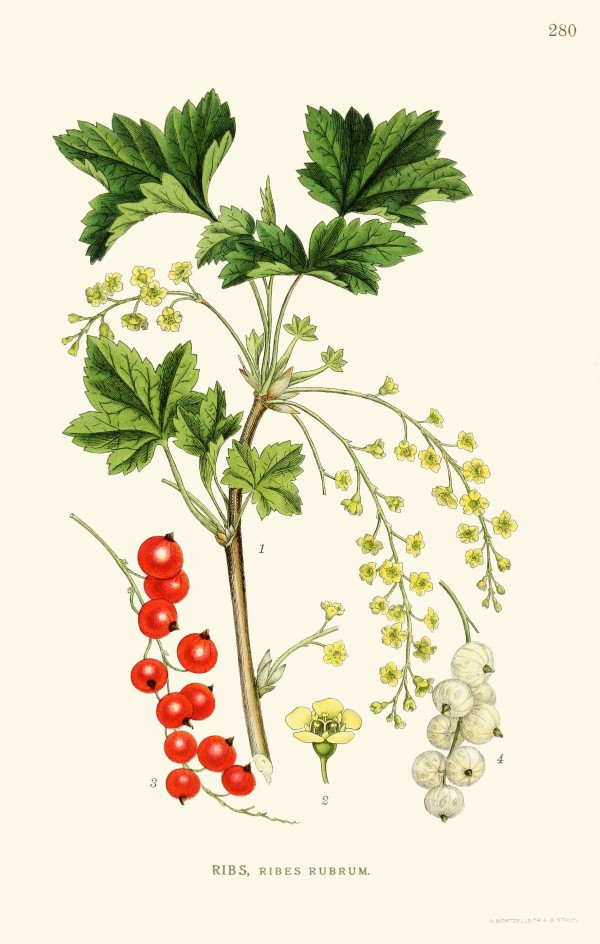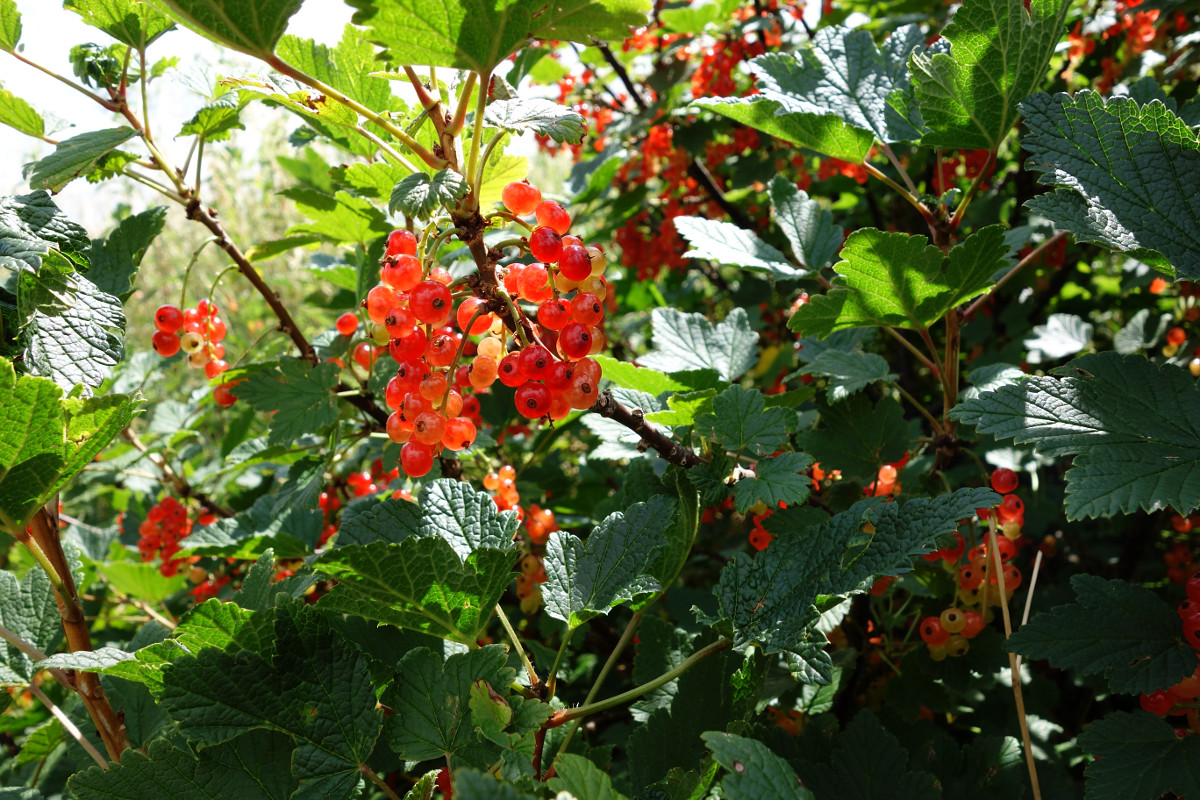Ribes rubrum L. - Grossulariaceae - redcurrant, Rote Johannisbeere
Deciduous shrub, up to 1.5m high, native to Europe, northern Asia, cultivated and naturalized throughout Europe; leaves 3-5 lobed, broadly ovate-triangular, margin serrate; racemes erect then nodding, 5-15-flowered, flower calyx greenish or greenish brown, petals purplish; fruit red, globose.
http://www.efloras.org/florataxon.aspx?flora_id=2&taxon_id=220011643
„With maturity, the tart flavour of redcurrant fruit is slightly greater than its blackcurrant relative, but with the same approximate sweetness. The albino variant of redcurrant, often referred to as white currant, has the same tart flavour but with greater sweetness. Although frequently cultivated for jams and cooked preparations, much like the white currant, it is often served raw or as a simple accompaniment in salads, garnishes, or drinks when in season… In German-speaking areas, syrup or nectar derived from the red currant is added to soda water and enjoyed as a refreshing drink named Johannisbeerschorle. It is so named because the redcurrants (Johannisbeeren, „John's berry“ in German) are said to ripen first on St. John's Day, also known as Midsummer Day, June 24.“
https://en.wikipedia.org/wiki/Redcurrant
Volatiles present both in fresh redcurrant fruit and processed juice were 1-methyl-4-isopropenyl toluol (p,α-dimethylstyrene ?), 1-pentanal, (E)-2-pentenal, benzaldehyde, 1-butanol, isopentanol, (Z)-3-hexenol, (E)-2-hexenol, 1-octen-3-ol, 4-terpineol, and 2-pentylfurane. On juice processing, hexanal and (Z)-3-hexenal are formed in intermediary steps, which are then rapidly reduced enzymatically to the analogue alcohols. Isomerisation of (Z)-3-hexenol leads to (E)-2-hexenal as main component in juices.
[Über die quantitative Zusammensetzung natürlicher und technologisch veränderter Aromen III. Veränderungen und Neubildungen von Aromastoffen bei der Herstellung von Säften aus roten Johannisbeeren., Schreier, P., Drawert, F., Junker, A., Lebensm.-Wiss. u. Technol, 10, 1977, 337-340]
„Application of chromatographic separation and taste dilution analyses recently revealed, besides a series of flavon-3-ol glycosides and (E)/(Z)-aconitic acid, four nitrogen-containing phytochemicals as the key astringent and mouth-drying compounds in red currants (Ribes rubrum). The isolation and structure determination of the astringent indoles 3-carboxymethyl-indole-1-N-β-d-glucopyranoside (1) and 3-methylcarboxymethyl-indole-1-N-β-d-glucopyranoside (2), as well as the astringent, noncyanogenic nitriles 2-(4-hydroxybenzoyloxymethyl)-4-β-d-glucopyranosyloxy-2(E)-butenenitrile (3) and 2-(4-hydroxy-3-methoxybenzoyloxymethyl)-4-β-d-glucopyranosyloxy-2(E)-butenenitrile (4) by means of 1D/2D NMR, LC-MS/MS, and UV−vis spectroscopy are reported. The structures of compounds 1 and 2 were confirmed by synthesis. Using the recently developed half-tongue test, human recognition thresholds for the astringent and mouth-drying nitrogen compounds were determined to be between 0.0003 and 5.9 μmol/L (water). In particular, the extraordinarily low threshold of 0.0003 μmol/L evaluated for the indole 1 represents the lowest recognition threshold of any astringent phytochemical reported to date.“
[Isolation, structure determination, and sensory activity of mouth-drying and astringent nitrogen-containing phytochemicals isolated from red currants (Ribes rubrum)., Schwarz, B., Hofmann, T., Journal of agricultural and food chemistry, Vol.55(4), 2007, 1405-1410]
Main volatile compounds with C6 skeleton of fresh juice of R.rubrum are C6 alcohols, notably (E)-hex-2-en-1-ol, followed by hexanol and (Z)-hex-3-en-1-ol. The aldehydes (E)-hex-2-enal and (Z)-hex-3-enal are present in small amounts (< 10 μg/L). Vanillin, 2-isobutyl-3-methoxypyrazine, sotolon, (Z)-hex-3-enal, acetic acid, pentanoic acid, (Z)-octa-1,5-dien-3-one, and furaneol showed the highest FD factors (≥ 16). Ten substances were odour-active (OAVs ≥ 1): (E)-ß-damascenone (fruity, canned peach), (Z)-hex-3-enal (grassy), 2-isobutyl-3-methoxypyrazine (green pepper), acetic acid (vinegar), oct-1-en-3-one (mushroom, metallic), (E)-hex-2-enal, (apple, marzipan), 2-isopropyl-3-methoxypyrazine (musty), pent-1-en-3-one (solvent), (Z)-hex-3-en-1-ol (fruity, sweet), and vanillin. A reconstitution model with the ten aroma active compounds showed the importance of these compounds, but the reconstructed aroma did not fully reflect the original aroma profile.
[Kapillargaschromatographische und sensorische Untersuchungen flüchtiger Verbindungen in Stachelbeeren (Ribes uva crispa L.) und Jostabeeren (Ribes x nidigrolaria Bauer)., Schrade, K.S., Doctoral dissertation, München, Technische Universität München, Diss., 2014] http://mediatum.ub.tum.de/doc/1183254/document.pdf
„The sensory evaluations of the different Ribes species revealed that (Z)-hex-3-enal is an odour-active substance with a high OAV in fruits of each of the Ribes species. (E)-ß-damascenone, the compound with the highest OAV in redcurrant berries, however, was not identified as an odour-active compound in fruits of any of the three other Ribes species and represents a distinguishing feature of the aroma of redcurrant fruits. Further, acetic acid, which was also identified as a compound with a high OAV in redcurrant berries, was only identified as an odour-active compound in gooseberry fruits via GC/O. Vanillin was not identified in the other Ribes species as an odour-active compound. The other odour-active compounds of redcurrant berries, i.e. (E)-hex-2-enal, (Z)-hex-3-en-1-ol, 2-isobutyl-3-methoxypyrazine, 2-isopropyl-3-methoxypyrazine, oct-1-en-3-one, and pent-1-en-3-one, were also identified in berries of blackcurrant, gooseberry, and/or jostaberry as odour-active compounds with an OAV > 1 (Hempfling et al. 2013a; Hempfling et al. 2013b; Schrade 2014).“
[Jung, Kathrin. Analysis and sensory evaluation of volatile constituents of blackcurrant (Ribes nigrum L.) and redcurrant (Ribes rubrum L.) fruits. Diss. Technische Universität München, 2018] https://mediatum.ub.tum.de/doc/1427712/file.pdf

Lindman, C.A.M., Bilder ur Nordens Flora, vol.2 t.280 (1922-1926)
http://www.plantillustrations.org/species.php?id_species=882170

Ribes rubrum fruits, CC BY-SA 3.0, Author: Andreas Kraska
